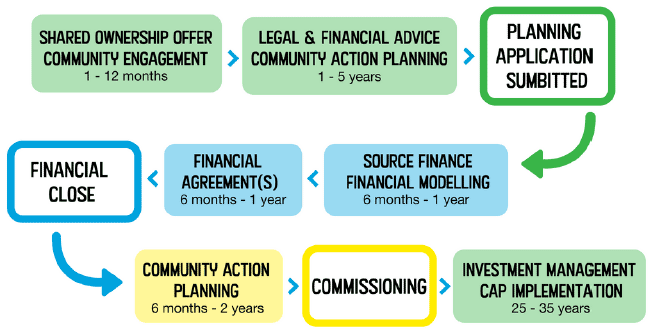Shared ownership of renewable energy developments - good practice principles: consultation
Draft version, for the purposes of public consultation, of Scottish Government's Good Practice Principles for Community Benefits from Onshore Renewable Energy Developments.
3. Shared Ownership Journey
This section sets out:
- Typical shared ownership journey
- Roles and responsibilities
- Timing of the investment
3.1 Context
This section aims to set out the key milestones, including roles and responsibilities for a "typical shared ownership journey" as highlighted in the diagram below. Please note, however, each project will be different, the milestones and timings identified are purely to give those involved a benchmark and all parties should bear this in mind when reading the guidance.
3.2 Typical Shared Ownership Journey
It is important that both communities and renewable energy businesses are able to understand key milestones in a project's journey, including when they will be required to make decisions.
The following key issues are worth highlighting:
- All parties should acknowledge the length of time it may take to conclude the process.
- It may be some time before the community sees a financial return from any investment.
- Recognition from all parties that the complex nature of developing the project, may result in setbacks and delays.

3.3 Roles and Responsibilities
The main roles and responsibilities are summarised in the Executive Summary.
The following tables provide guidance on key project milestones: from the pre-planning stages of the development to the commissioning of the project (along with the roles/ responsibilities of the renewable energy industry and community at each stage). As advised above this is only a guide.
| Stage |
Roles, Responsibilities and Key Milestones |
|
|---|---|---|
| Renewable energy business |
Community |
|
| Pre planning application: Community engagement |
|
|
| Pre planning application: Seek independent professional advice |
|
|
| Financial Close: Source financial modelling Financial Agreements |
|
|
| Financial Close: Community Action Planning |
|
If a community action plan is not already in place, consider developing one to ensure income from the shared ownership proposal can be spent accordingly:
|
| Commissioning: Investment Management (if applicable) |
|
|
| Post Commissioning: Community Action Plan Implementation |
|
|
The role and responsibilities of Planning Authorities are explained further in Section 4.
3.4 Timing of investment
Each business will have its own policy on the timing of an investment offer to a community. For example, some investment opportunities may be available to communities pre-planning (these are higher risk), while others may enable the community to invest later in the development process, for example, at financial close or post commissioning.
The key investment points are:
Pre-scoping
Scoping
Pre-planning
Planning submission
After consent
From Final Investment Decision (FID)
During construction
At commissioning
Post commissioning
If the community intends to invest post-planning, an agreement of intent should be signed in advance of submission of a planning application (where appropriate). Clear and transparent public meeting minutes may suffice where both parties are content. Early dialogue with all concerned to explore the timing of the investment is encouraged.
As advised previously, developing a renewable project is complex, and communities should seek independent professional advice as necessary. For example, where a community is considering a joint venture (private limited company), there are legislative restrictions on the detail of early discussions. Awareness of these restrictions and other issues should help to reduce unexpected issues delaying a project.
Local Energy Scotland can help support communities to explore opportunities, and appoint relevant professional advisors, as required. Further details at section 6.
Contact
Email: Lorne Frew
There is a problem
Thanks for your feedback